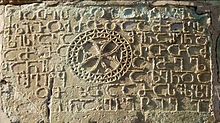Bolnissi inscriptions
The Bolnissi inscriptions ( Georgian ბოლნისის წარწერები ) are three inscriptions on the Bolnissis Sioni church near the town of Bolnissi in Georgia . They are dated to the end of the 5th century and are among the oldest evidence of the Georgian language and script . They are even considered to be the oldest Georgian written monuments on Georgian soil (after the inscriptions in a former Georgian monastery church near Bethlehem that were a few decades older ).
First inscription

The first inscription is on a stone embedded in the eastern outer wall of the church above the apse window . The raised chiseled letters in Assomtawruli script are arranged in eight lines around a relief medallion in the middle that contains a Bolnissi cross .
The inscription reads:
“ქ ~ ე დ ~ თ ეპისკოპოსი კრებ
ულითურთ და ამას ეკ
ლესიასა ______ შინა შენდ
ა მიმა _________ რთ თაჳ
ყანისმ _________ ცემელ
ნი შეიწყ ______ ალენ და
მშრომელთა ამას ეკლე
სიასა შინა შეხეწიე. ი ი. "
Translation:
"Christ, have mercy on Bishop David's congregation and those who worship you in this church, and help those who work in this church." The following are two ი (I) by the Georgian philologist Korneli Kekelidze as twofold იყავნ “so be it” were interpreted.
Second inscription
The second inscription was originally on a stone lintel above the left door on the north side of the church. Later the stone broke through in two places, so that only its two end pieces remained in the wall. The end of the line and, in particular, the beginning of the four-line inscription, which are on the remaining parts, can hardly be deciphered today. The broken-off part, rediscovered during an excavation in 1937, is better preserved, the replica of which was returned to its original location. The original, like the original stone of the first inscription, is kept in the Simon Janaschia State Museum in Tbilisi .
The inscription reads (with additions in square brackets):
"[შეწევნითა წმი] დისა სამებისაჲთა ოც წლისა პეროზ მეფი [სა ზე]
[ხიქმნა დაწყებაჲ] ამის ეკლესიაჲსაჲ და ათხუთმეტ წლის [ა შემდგომად]
[განხეშორა. ვი] ნ აქა შინა თაჳყანის ხცეს ღ ~ ნ შეიწყალენ და ვინ ა [მის ეკლ]
[ესიაჲსა დ ~ თ ე] პისკოპოსსა ხულოცოს იგიცა ღ ~ ნ შეიწყალენ. [ა ~ ნ.] "
Translation:
“[With the help of the Holy] Trinity [happened] in the twentieth year of King Peroz [construction began] of this church, and in the fifteenth year after it was completed. Whoever shows veneration in this, may God have mercy, and whoever prays for the bishop of this church, David], may God have mercy on him too. [Amen.]"
The reign of King Peroz I of Persia mentioned in the text falls in the years 459-484, therefore the construction of the Sioni Church should have started in 479 and completed in 493/494, during the reign of the Persian King Kavadh I. (488-531).
Third inscription
The third inscription is also on the north side, above the right door, and relates to the installation of this door:
"შეწევნითა ქრისტჱესითა მე ფარნ ... და აზარუხტ შეხუაბთ ესე კარი სალოცველად სულთა ჩუენთათჳს."
Translation:
"With the help of Christ we, I Parn ... and Azarucht, hung this door to pray for our souls."
Others
All three inscriptions show an ancient form of the Georgian Assomtavruli letters with arches closed at the top ( Tawschekruloba ), while later they were written as open arches. In all three texts there are also examples of a later failed enen (ch), which is typical for the oldest Georgian linguistic monuments up to the 7th century (so-called Chanmeti texts).
Individual evidence
- ^ BG Hewitt: Georgian. A structural reference grammar. Amsterdam / Philadelphia 1995, p. 4
- ↑ Heinz Fähnrich, The Georgian Language , Leiden / Boston 2012, p. 7.
- ↑ Heinz Fähnrich, The Georgian Language , Leiden / Boston 2012, p. 9.
